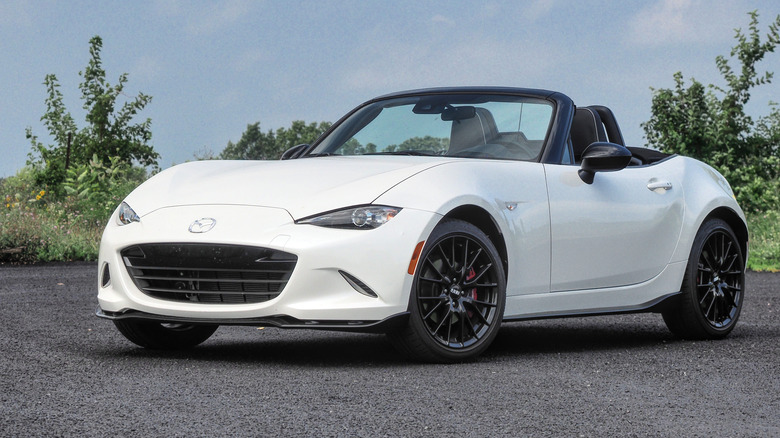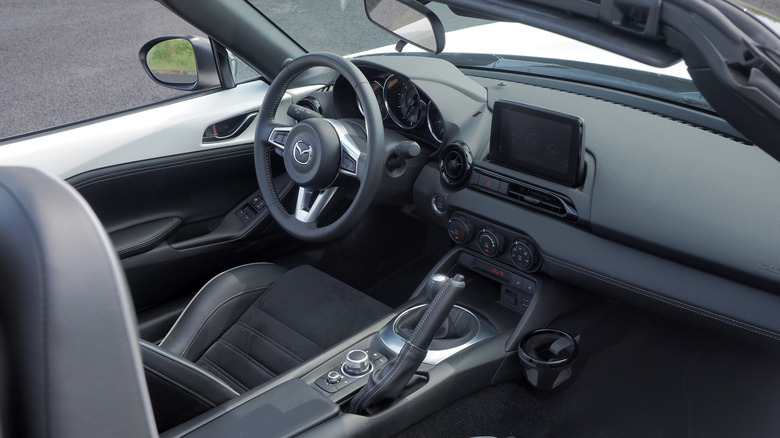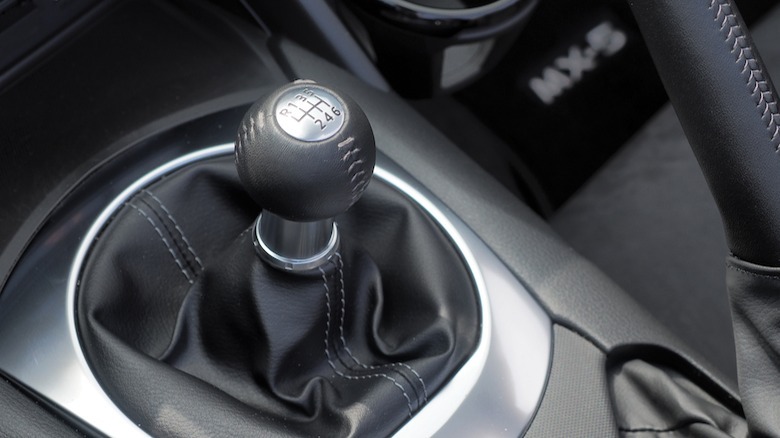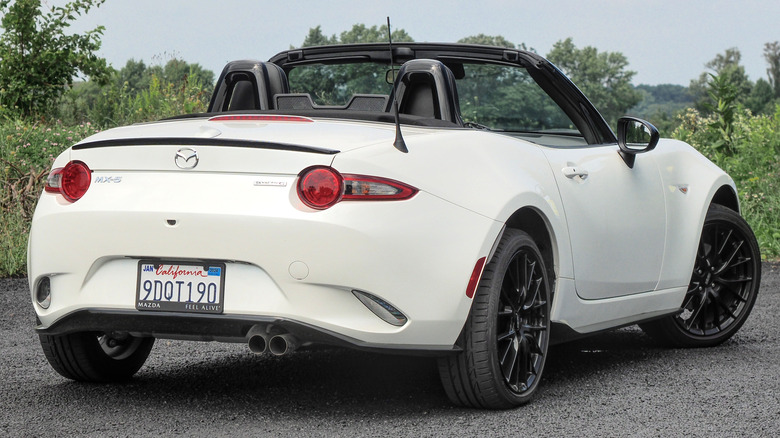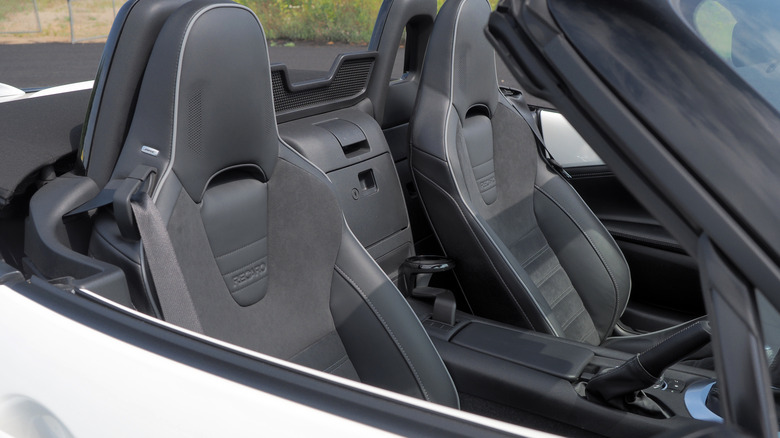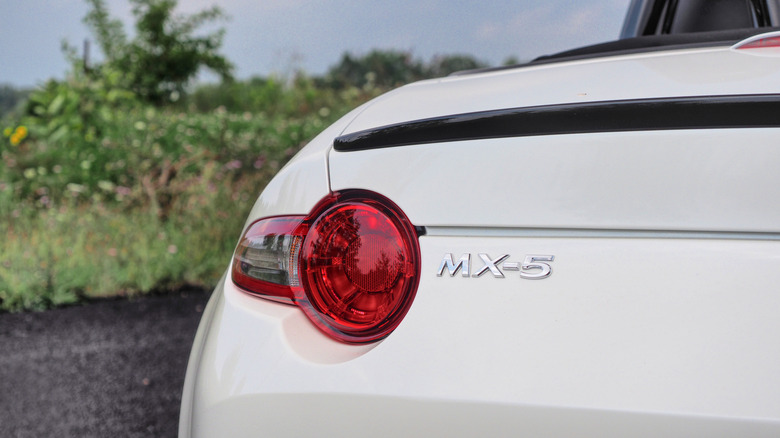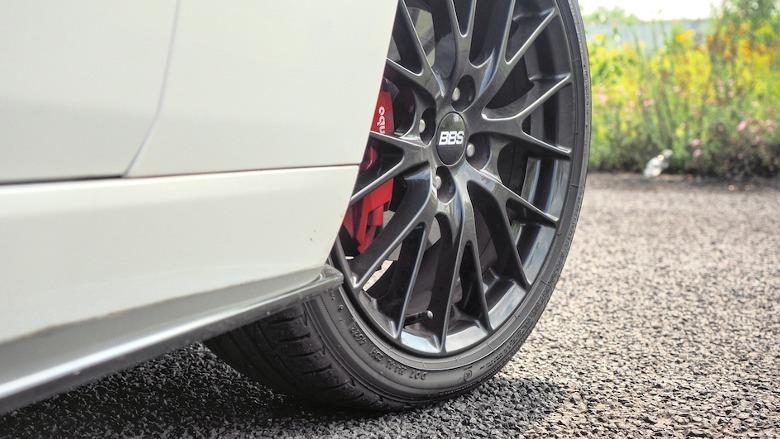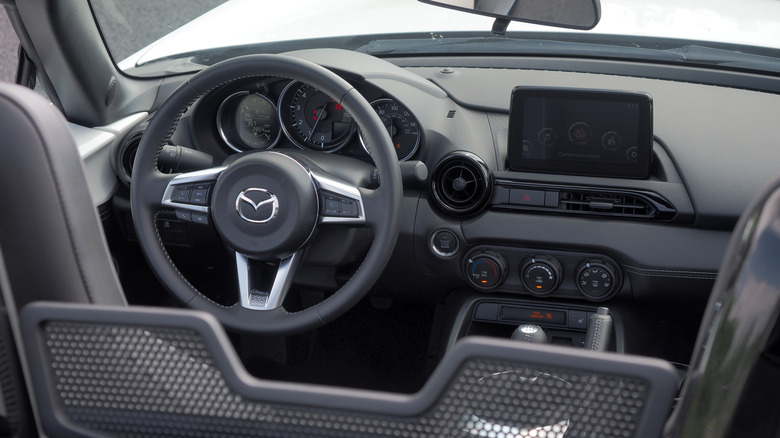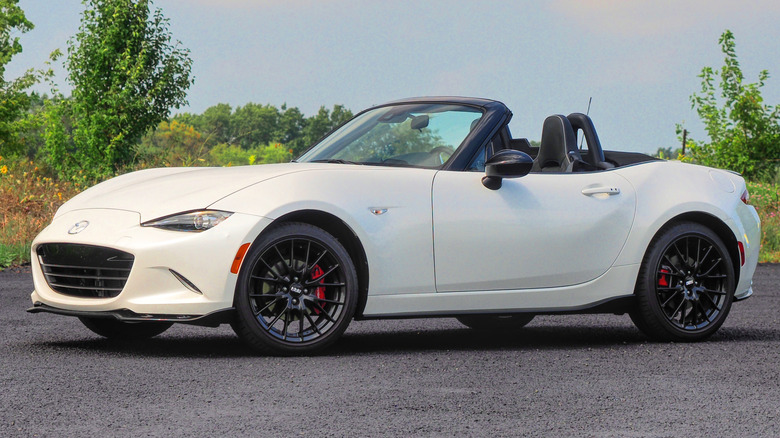2023 Mazda MX-5 Miata: Fun And Affordable, But Is It Fast Enough?
It is 7:00 a.m., I am unshowered, and my grin is probably wider than the tires on the 2023 Mazda MX-5 Miata. There's no question that pointing the little convertible's nose away from suburbia and out in search of lesser-traveled backroads is a good idea. The best idea, actually, even if you only have 20 or 30 minutes to spare.
In the time it takes for many larger, more potent, more expensive, more serious sports cars to warm up, the dinky Mazda has already skittered around a handful of corners like a giddy puppy. When you're seated low down, what feels like scant inches from the asphalt and gravel, the MX-5 always feels faster than it actually is.
Snackable fun, the Miata represents, sandwiched in between adult responsibilities like desk jobs and emptying the dishwasher. A day out in mountain twisties would be sublime, but Mazda's roadster isn't so greedy as to monopolize your time. The very factors that make it so affordable — moderate power and tried-and-tested engineering — also make it entertaining without demanding driving at the limit.
The one Miata spec not to compromise on
Car preferences may be subjective, but on one thing most automotive writers can agree: the Miata's manual transmission is a thing of beauty. The standard six-speed stick shift in the 2023 MX-5 continues Mazda's tradition of making rowing your own gears the default, and while an automatic option was available from the original NA first-generation car, actually opting for that feels like you're missing the point.
In keeping with the Miata spirit, it's a joyful and friendly little transmission. Some manuals demand constant hyper-attention, punishing casual drivers with that embarrassing (and potentially expensive) crunch of misaligned cogs. Others double as a workout for your arm and foot, confusing heft with a sense of enthusiast engagement.
Not so the spritely MX-5. Mazda's transmission of choice slicks easefully between its ratios: neither floppy and imprecise, nor finicky and stiffly-notched. The clutch hovers in the sweet spot between light enough to live with every day — even in urban traffic — without leaving the bite point too vague. All combined, there's a playful joy here, which is good since the Miata needs a little work to keep on maximum boil.
Is the Mazda MX-5 Miata powerful enough?
When it comes to power, you could argue that Mazda's diminutive roadster is the poster child for less-is-more. Although there have been a few shake-ups in what, exactly, is under the hood over the years — including a 1.5-liter four-cylinder for some regions, where the North American-spec car currently gets a 2.0-liter version — the core premise is still the same. Better to have relatively humble horsepower that you can use to the full, rather than be awash with power you only ever tap a fraction of.
The 2.0-liter inline-four, for example, brings just 181 horsepower and 151 lb-ft of torque to the party. That's fewer horses, incidentally, than you get in a Toyota Prius.
Mazda really wants you to use each and every one of the ponies you paid for. Peak horsepower doesn't hit until 7,000 rpm — just 500 rpm from the MX-5's redline — and peak torque doesn't land until 4,000 rpm. Unlike super-powerful sports cars, you can't just rely on low-end grunt to keep you simmering: the answer is invariably to downshift and make sure the Miata's four-pot is constantly on the bubble.
Weight is everything
Remember that Prius? Its 3,100+ pound curb weight makes it more than 750 pounds heavier than the Miata, and a stark reminder of some old sports car lore. Colin Chapman may have been talking about Lotus when he said to "simplify, then add lightness," but it's a message the Mazda team heard loud and clear.
The MX-5's 2,341-pound heft (in manual form) makes it a minnow in an age of beefy SUVs and crossovers. It also makes the roadster eminently throwable: less weight means you don't need excessive power to get up to speed. When it comes to slowing, you don't need outsized brakes either: 11-inch discs front and rear make do with mere single-piston calipers.
It all adds up to a spritely experience that in some ways is more akin to a sports bike than a modern car. Indeed, one of our biggest questions in this new age of electrification is just how Mazda is going to manage eventually turning the Miata into an EV, without putting on serious weight in the process.
The Miata can be your only car ... with caveats
In an ideal world (or a Mazda commercial), every drive would be an exhilarating whip around curving backroads and sinuous oceanside highways, where slower cars always pull over for you, and stop lights are a distant memory. Reality is a little less accommodating. While the manual Miata has arguably everything you need for a weekend plaything, day-to-day driving comes with some compromises.
For once, it's not the stick shift that is the issue, here. Mazda's slick transmission and fairly light clutch pedal mean the MX-5 isn't exhausting to drive, even in heavy urban traffic. While an auto-hold brake system would be a neat addition, the traditional handbrake is fine.
Where the challenges arise are in space and visibility. The Miata's cabin is snug, and taller (or wider) drivers may find themselves with less-than-comfortable degrees of head, shoulder, and hip room. In-cabin storage is another issue: Mazda's pop-out cup holders are just about adequate for a beverage, but not really secure enough for a phone or anything else, while the lockable cubby between the seats is laughably small. The 4.6 cu-ft trunk with its relatively narrow opening means soft-sided luggage is probably worth investing in.
Then there's the experience of driving on typical American roads. The fact that the Miata is diminutive while most of the traffic around it has swollen to comical (or depressing, you take your pick) sizes isn't really Mazda's fault, but that doesn't make you feel any more comfortable when you glance out the window and your view is filled with a truck tire. Highway trips can be particularly stressful, demanding hyper-vigilance since the MX-5 can get easily lost in an SUV's blind spot.
Mazda's aggressive cost savings are right in front of you
In new car terms, the Miata is a bargain. 2023 MX-5 ownership starts at a frankly ridiculous $28,050 (plus $1,165 destination) for the base Sport trim. A top-spec MX-5 Grand Touring is still only $33,050 (plus destination). Meanwhile, arguably the sweet spot of the Miata line-up — the build-to-order Club — is $31,550 (plus destination).
At these prices, it's not exactly surprising that you can't have everything from your budget roadster. Mazda has, wisely, opted to spend on engineering first and then stretch what's left across things like cabin plastics and technology. The result is some notably cheaper-feeling trim, plus an infotainment system that feels old-fashioned (despite having a touchscreen, it demands you use the jog-dial while the Miata is in motion) and is nowhere near bright enough on the 7-inch display.
Though you could stay just under $30k with your new Miata, the Club spec is probably where most people should begin their shopping. It gets a Bose audio system with more speakers, wireless rather than wired Apple CarPlay, and larger 17-inch wheels instead of the Sport's 16-inchers. Only Club-spec and up (manual) Miata get the torque-sensing limited-slip differential, too.
How long can Mazda keep this up?
The automotive landscape has changed considerably since the first-generation Miata NA was launched all the way back in 1989. In fact, that landscape has pretty much been bulldozed and reshaped entirely. Though the enthusiast without big money to spend still has some options — yes, Elantra N, Civic Type R, and GR Corolla, we're looking at you — small, affordable convertibles aren't exactly filling up dealership lots.
Meanwhile, the MX-5 faces an industry already bracing for another huge change. Electrification currently means big, heavy batteries squeezed into the SUV bodies that can mask them most effectively. In other words, the anathema of Miata.
Mazda's gradual evolution of the car that represents its core ethos does have one big side bonus. Early ND-generation Miata commands even more attainable prices on the used market: a model year 2016 MX-5, right at the start of the fourth generation, can be found hovering around the $21k mark. Yes, you might miss out on that new-car smell, but on a dollar-per-grin basis, there's little to rival it.
